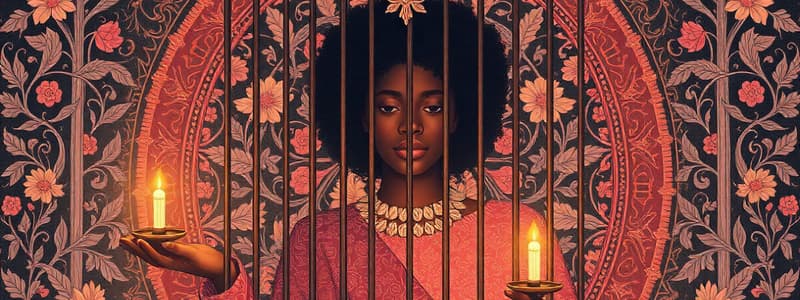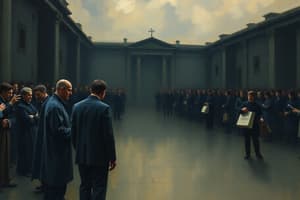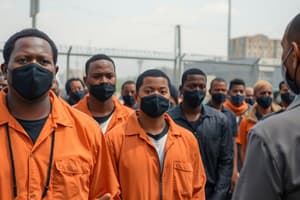Podcast
Questions and Answers
What is described as a new form of racial control in the United States?
What is described as a new form of racial control in the United States?
- The Affordable Care Act
- Mass incarceration (correct)
- The Voting Rights Act
- The War on Drugs
Which group played a significant role in the backlash against African American gains during the Reconstruction Era?
Which group played a significant role in the backlash against African American gains during the Reconstruction Era?
- Freedom Riders
- The National Guard
- Northern Democrats
- The Ku Klux Klan (correct)
What role did federal troops play in the aftermath of the Reconstruction Era?
What role did federal troops play in the aftermath of the Reconstruction Era?
- They supported the Populist movement.
- They protected African American communities.
- They enforced civil rights legislation.
- They were withdrawn from the South. (correct)
What was one of the main philosophies of race relations that emerged during the period of the new Jim Crow?
What was one of the main philosophies of race relations that emerged during the period of the new Jim Crow?
How did the War on Drugs impact African American communities according to the book's analysis?
How did the War on Drugs impact African American communities according to the book's analysis?
What system did convict leasing replace following the end of the Civil War?
What system did convict leasing replace following the end of the Civil War?
Which movement sought to create a multiracial alliance against wealthy elites?
Which movement sought to create a multiracial alliance against wealthy elites?
What is highlighted as a necessary action to dismantle the new caste system created by mass incarceration?
What is highlighted as a necessary action to dismantle the new caste system created by mass incarceration?
Flashcards
New Jim Crow
New Jim Crow
A new system of racial control in the United States, replacing Jim Crow, using mass incarceration to target and marginalize people of color.
War on Drugs
War on Drugs
A campaign focused on drug enforcement, often used as a tool to target and disproportionately incarcerate people of color.
Jim Crow Era
Jim Crow Era
A period of legalized racial segregation and discrimination in the Southern United States.
Mass Incarceration
Mass Incarceration
Signup and view all the flashcards
Reconstruction Era
Reconstruction Era
Signup and view all the flashcards
Racial Control
Racial Control
Signup and view all the flashcards
Convicted leasing
Convicted leasing
Signup and view all the flashcards
Three philosophies of race relations (Liberalism, Conservatism, Radicalism)
Three philosophies of race relations (Liberalism, Conservatism, Radicalism)
Signup and view all the flashcards
Study Notes
The New Jim Crow: Mass Incarceration in the Age of Colorblindness
- Book by Michelle Alexander
- Examines mass incarceration in the US as a modern form of racial oppression
- Book argues that despite the legal dismantling of Jim Crow laws, racial inequality persists through the criminal justice system
- The 13th Amendment to the US Constitution abolished slavery except as punishment for a crime
The Birth of Jim Crow
- Backlash against Reconstruction Era gains for African Americans led to violence and the withdrawal of federal support
- Terrorist campaigns against Reconstruction governments and local leaders
- Vagrancy laws and other laws targeting blacks were aggressively enforced
- Conviction leasing systems, similar to slavery, exploited African Americans as forced labor
- The Thirteenth Amendment's exception for slavery as punishment for crime
- Courts ruled that convicts were similar to slaves, having limited legal rights
The Rebirth of Caste
- The rise of Jim Crow laws marked a shift in racial strategy to maintain racial hierarchy through caste-like social structures
- Segregation laws were implemented to divide poor whites and blacks
- Different racial philosophies emerged to combat segregation
- Liberalism: criticized segregation's hypocrisy
- Conservatism: blamed liberals for elevating blacks and used race to control working class whites
- Radicalism: viewed privileged classes as conspiring with large corporations to control both poor black and whites
- The Populist Movement, an alliance of poor whites and blacks, attempted to challenge the racial divide
- Populists faced strong opposition and their alliance eventually broke down
- Jim Crow laws took dominance as a racial caste system, impacting every aspect of life
- Jim Crow was seen as a "natural" social order justified by white supremacy
Studying That Suits You
Use AI to generate personalized quizzes and flashcards to suit your learning preferences.




